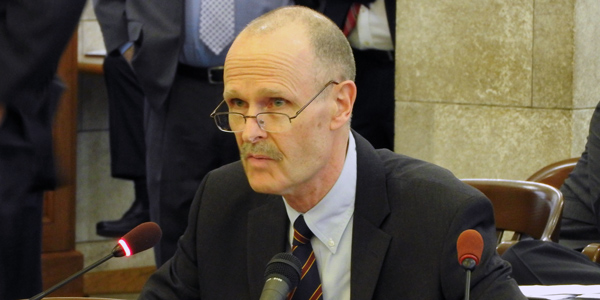Stakeholders got a look Thursday at PJM’s initial response to FERC’s ruling this month on its expanded minimum offer price rule (MOPR).
Chen Lu, PJM senior counsel, presented the Markets and Reliability Committee with highlights of the order, issued Oct. 15, and the additional revisions the RTO must file by Nov. 16 (EL16-49-003, et al.). FERC accepted most of PJM’s compliance filing while reversing its position on state-directed default service auctions. (See FERC Acts on PJM MOPR Filing.)
Lu said FERC largely accepted PJM’s definition of a state subsidy, which included carve-outs for state default procurement auctions and for programs like the Regional Greenhouse Gas Initiative.
“We think this order results in a workably competitive outcome for the markets,” Lu said.
The RTO has little discretion to modify the compliance language directed by FERC, so PJM does not anticipate any additional stakeholder meetings to complete the filing, he said.
MOPR Order Highlights
FERC indicated in the order that the upcoming Base Residual Auction (BRA) date cannot be set until an order on the pending energy and ancillary services compliance filing is resolved, Lu said. That filing was made by PJM in August, he said, with the hope of getting a decision by FERC before the end of the year.
Because pre-auction activities are pegged off the BRA date, Lu said, no deadlines for them may yet be set. PJM is currently evaluating activities that may begin on a voluntary basis for capacity market sellers wishing to start the process early, Lu said. A review of the pre-auction activities will be held with stakeholders at the Market Implementation Committee meeting Nov. 5.
Lu pointed to FERC’s decision on the treatment of state default procurement auctions that have a renewable portfolio standard component. As long as they are competitive and nondiscriminatory and meet criteria outlined in the definition of state subsidy, Lu said, then they will not be deemed state subsidies.
But Lu called to attention a footnote in the order that reads, “While this order accepts the exemption that PJM has proposed, it does not constitute a ruling that any particular state-directed default service auction actually meets these requirements.” FERC used New Jersey’s auction as an example of an auction that would not meet its requirements. Commissioner Richard Glick highlighted this in his dissent, saying that New Jersey’s and other state default procurement auctions that have an RPS component may be deemed by FERC to be a subsidy.
PJM is taking “a little bit of a different view” of the footnote, Lu said. The RTO believes the footnote is “meant as a cautionary tale” to warn New Jersey and other states not to change existing default state procurement auction rules in a way that would allow new renewable resources to escape the MOPR though the limited carve-out, he said.
The RTO is currently working with the Independent Market Monitor and will provide “guidance to all stakeholders” on how the existing state default procurement auctions in the footprint will be treated for the upcoming BRA, Lu said.
He also highlighted the scope of an exemption for incentives designed to promote “general industrial development in an area.” He said the commission rejected a request by a party in the docket to “explicitly include entire electric generation resources” that may have benefited from some sort of industrial development.
FERC ruled that general pollution-control equipment should still be exempt from the definition of a state subsidy, while state programs like tax exemptions for standalone renewable facilities are not exempt and would be deemed a capacity resource with state subsidies.
Lu used as an example a law in Virginia that exempts property taxes for certain pollution control equipment and facilities. He said the definition of pollution-control equipment in Virginia includes entire solar facilities that would also be exempt from property taxes, thereby making it a state subsidy.
Stakeholder Questions
Ken Foladare of Tangibl asked why PJM specifically highlighted renewable facilities in its presentation as generation resources benefiting from state subsidies. He said there are similar laws in other states benefiting natural gas- and coal-fired power plants, along with nuclear plants.
He pointed to a Kentucky law that says a company that owns and operates a coal-fired plant may be entitled to an incentive tax credit. He said almost every generation project he worked on had some sort of state or local tax incentive specifically designed for the generation facility being constructed.
“If you’re going to be singling out solar, you’re going to have to be singling out everybody,” Foladare said. “And pretty much every plant in PJM is going to be subject to MOPR.”
Paul Sotkiewicz of E-Cubed Policy Associates asked what happens to the timing of a BRA if PJM and the Monitor cannot agree on state subsidy cases or if a market participant disagrees with a decision and appeals to FERC instead.
Lu said it is ultimately a capacity market seller’s responsibility to certify if there is a subsidy or not, and FERC has already approved Tariff language describing how market sellers can challenge decisions.
Sotkiewicz said he views the process as being “thrown back on the market participant” to take the litigation and enforcement risk and ultimately dragged through a process that may vindicate their challenge in the end. He said it also “drags the entire market through a mess” where stakeholders are not sure what to believe in the market results.
“The more definitive we can be on this, the better off we are,” Sotkiewicz said. “And this is not necessarily PJM’s doing. The way FERC came down with this is a major part of the problem.”
Monitor Joe Bowring said he recognizes there is still uncertainty surrounding the MOPR. He said his and PJM’s goal is not to add any additional uncertainty in the process.
“We are making every effort to work closely with PJM to try to ensure we come to an agreement, make rational decisions and do it far enough ahead of time to minimize risk,” Bowring said.






